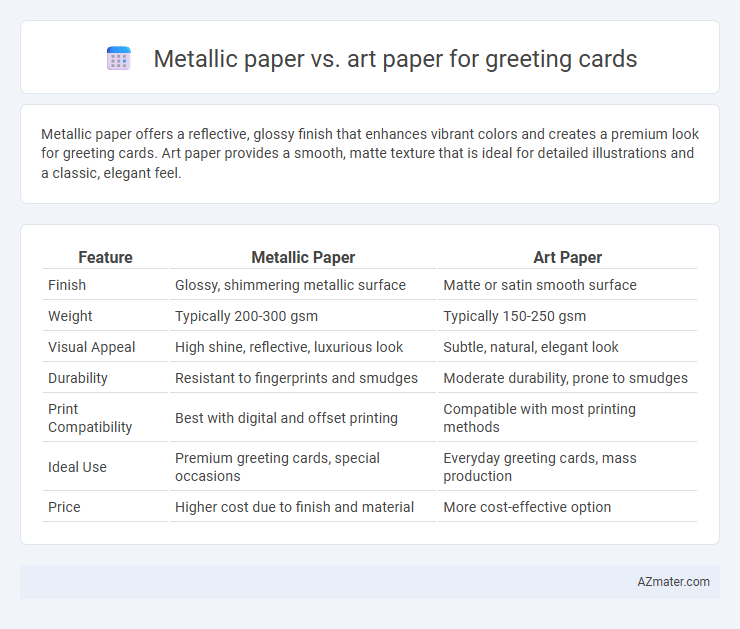Metallic paper offers a reflective, glossy finish that enhances vibrant colors and creates a premium look for greeting cards. Art paper provides a smooth, matte texture that is ideal for detailed illustrations and a classic, elegant feel.
Table of Comparison
| Feature | Metallic Paper | Art Paper |
|---|---|---|
| Finish | Glossy, shimmering metallic surface | Matte or satin smooth surface |
| Weight | Typically 200-300 gsm | Typically 150-250 gsm |
| Visual Appeal | High shine, reflective, luxurious look | Subtle, natural, elegant look |
| Durability | Resistant to fingerprints and smudges | Moderate durability, prone to smudges |
| Print Compatibility | Best with digital and offset printing | Compatible with most printing methods |
| Ideal Use | Premium greeting cards, special occasions | Everyday greeting cards, mass production |
| Price | Higher cost due to finish and material | More cost-effective option |
Introduction to Metallic Paper and Art Paper
Metallic paper features a glossy, reflective surface that enhances color vibrancy and adds a luxurious sheen, making it ideal for eye-catching greeting cards. Art paper, often matte or textured, provides a smooth or handcrafted feel with excellent ink absorption, perfect for detailed designs and subtle color tones. Choosing between metallic and art paper depends on the desired visual impact and tactile experience for the greeting card.
Key Differences Between Metallic and Art Paper
Metallic paper boasts a glossy, reflective surface that enhances color vibrancy and adds a premium shimmer to greeting cards, while art paper offers a matte or satin finish ideal for detailed artwork and text clarity. Metallic paper typically has a thicker, more rigid texture providing durability, whereas art paper is smoother and more flexible, supporting a variety of printing techniques like offset and digital. The key differences lie in visual impact--metallic paper delivers eye-catching brilliance, and art paper ensures elegant subtlety and versatility in design presentation.
Visual Appeal: Which Paper Stands Out?
Metallic paper offers a shiny, reflective surface that enhances colors with a luminous, eye-catching effect, making greeting cards appear vibrant and luxurious. Art paper, known for its rich texture and matte or satin finish, provides a sophisticated and classic look that emphasizes intricate designs and fine details. For visual appeal, metallic paper stands out with its bold brilliance, while art paper excels in elegance and depth.
Texture and Feel: Tactile Experience Compared
Metallic paper offers a smooth, reflective surface with a subtle shimmer that enhances visual appeal and creates a luxurious tactile experience, ideal for eye-catching greeting cards. Art paper features a slightly textured, matte or semi-gloss finish, providing a more natural and handcrafted feel that appeals to recipients who appreciate artisanal quality. The choice between metallic and art paper influences the greeting card's sensory impact, with metallic paper emphasizing sleek modernity and art paper conveying warmth and tradition.
Printing Quality on Metallic vs Art Paper
Metallic paper offers a unique reflective finish that enhances colors with a vibrant, glossy sheen, making images appear more vivid and luxurious compared to art paper. Art paper, typically matte or semi-gloss, provides smooth, consistent printing quality with excellent detail reproduction but lacks the luminous impact of metallic finishes. For greeting cards, metallic paper delivers eye-catching brilliance and depth, while art paper ensures sharp text and subtle color gradients for a classic, elegant look.
Durability and Lifespan for Greeting Cards
Metallic paper offers superior durability for greeting cards due to its resilience against moisture and wear, ensuring vibrant, long-lasting prints with a reflective finish. Art paper, while aesthetically pleasing with its matte or textured surface, tends to be more susceptible to creasing and fading over time, reducing the card's lifespan. For greeting cards intended to be keepsakes or displayed, metallic paper provides enhanced longevity and preservation of visual quality.
Cost Comparison: Metallic Paper vs Art Paper
Metallic paper generally costs more than art paper due to its specialty coating that enhances shimmer and visual appeal, making it ideal for premium greeting cards. Art paper, often made from high-quality fibers with smooth texture, provides a more budget-friendly option without compromising print clarity. Choosing between metallic paper and art paper hinges on budget constraints and desired aesthetic impact for greeting card production.
Eco-Friendliness and Sustainability Factors
Metallic paper often contains synthetic coatings and aluminum, making it less biodegradable and harder to recycle compared to art paper, which is usually made from natural fibers and often available in recycled or FSC-certified options. Art paper supports eco-friendliness due to its lower environmental impact during production, especially when sourced from sustainable forestry practices and processed without harmful chemicals. Choosing art paper for greeting cards contributes to reduced carbon footprint and enhanced sustainability in paper consumption.
Ideal Use Cases for Each Paper Type
Metallic paper offers a glossy, reflective finish ideal for greeting cards that require a luxurious and eye-catching appearance, such as holiday cards, invitations, or special event announcements. Art paper, known for its smooth texture and excellent ink absorption, is perfect for cards featuring detailed illustrations, watercolor designs, or handwritten messages that emphasize artistic quality and tactile appeal. Choosing metallic paper enhances visual impact and elegance, while art paper provides a refined, classic look suited for artistic and personalized greetings.
Choosing the Best Paper for Your Greeting Cards
Metallic paper offers a reflective, shiny finish that enhances color vibrancy and creates a premium look for greeting cards, making it ideal for festive or celebratory occasions. Art paper provides a smooth, matte surface with excellent ink absorption, resulting in rich, detailed prints suitable for elegant or artistic designs. Selecting the best paper depends on the desired visual impact and the type of greeting card, with metallic paper emphasizing boldness and art paper delivering sophistication and subtlety.

Infographic: Metallic paper vs Art paper for Greeting card
 azmater.com
azmater.com